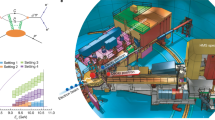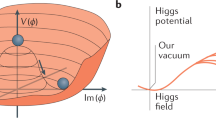Abstract
The theoretical observation that gauge symmetries are generally restored at sufficiently high temperature has led us to consider here the conjecture that gauge symmetries are broken at sufficiently low temperature. The photon, for example, would then acquire a non-zero mass mγ below some low temperature T0. Above this phase-transition temperature, the photon would be strictly massless. Present observational limits on the photon mass show only that mγ is negligible for T > 2.7 K ∼10−4 eV. Although we have not discovered any plausible mechanism for electromagnetic gauge-symmetry breaking and therefore cannot estimate T0 or mγ, there is a considerable range of experimentally accessible low temperatures for which there are no stringent constraints on mγ. Non-zero gluon or graviton masses at low temperatures could also have observable consequences.
This is a preview of subscription content, access via your institution
Access options
Subscribe to this journal
Receive 51 print issues and online access
$199.00 per year
only $3.90 per issue
Buy this article
- Purchase on Springer Link
- Instant access to full article PDF
Prices may be subject to local taxes which are calculated during checkout
Similar content being viewed by others
References
Dolan, L. & Jackiw, R. Phys. Rev. D9, 3320–3341 (1974).
Weinberg, S. Phys. Rev. D9, 3357–3378 (1974).
Linde, A. D. Phys. Rep. 42, 389–435 (1979).
Mohapatra, R. N. & Senjanovic, G. Phys. Rev. Lett. 42, 1651–1654 (1979).
Georgi, H. & Glashow, S. Phys. Rev. Lett. 32, 43–440 (1974).
Langacker, P. SLAC Preprint (SLAC-PUB-2544, 1980).
Goldhaber, A. S. & Nieto, M. N. Rev. Mod. Phys. 43, 277–296 (1971).
Davis, L., Goldhaber, A. S. & Nieto, M. N. Phys. Rev. Lett. 35, 1402–1405 (1975).
Pagels, H. Phys. Rev. D21, 2336–2347 (1980).
Stern, R. Phys. Rev. D14, 2081–2089 (1976).
LaRue, G. S., Fairbank, W. M. & Phillips, J. D. Phys. Rev. Lett. 42, 142–145 (1979).
De Rujula, A., Giles, R. C. & Jaffe, R. L. Phys. Rev. D17, 285–301 (1978); D22, 227–228 (1980).
Georgi, H. Phys. Rev. D22, 225–226 (1980).
Yang, C. N. Phys. Rev. Lett. 33, 445–447 (1974).
Fairchild, E. Phys. Rev. D16, 2438–2447 (1977).
Zee, A. Phys. Rev. Lett. 42, 417–421 (1979); 44, 703–706 (1980).
Smolin, L. Nucl. Phys. B160, 253–268 (1979).
Ford, L. H. & Van Dam, H. Nucl. Phys. B169, 126–136 (1980).
Author information
Authors and Affiliations
Rights and permissions
About this article
Cite this article
Primack, J., Sher, M. Photon mass at low temperature?. Nature 288, 680–681 (1980). https://doi.org/10.1038/288680a0
Received:
Accepted:
Issue Date:
DOI: https://doi.org/10.1038/288680a0
This article is cited by
-
Detecting torsion from massive electrodynamics
General Relativity and Gravitation (1993)
-
New definition of the metre
Nature (1983)
-
Absence of thermal effects on photon mass measurements
Nature (1982)
Comments
By submitting a comment you agree to abide by our Terms and Community Guidelines. If you find something abusive or that does not comply with our terms or guidelines please flag it as inappropriate.



